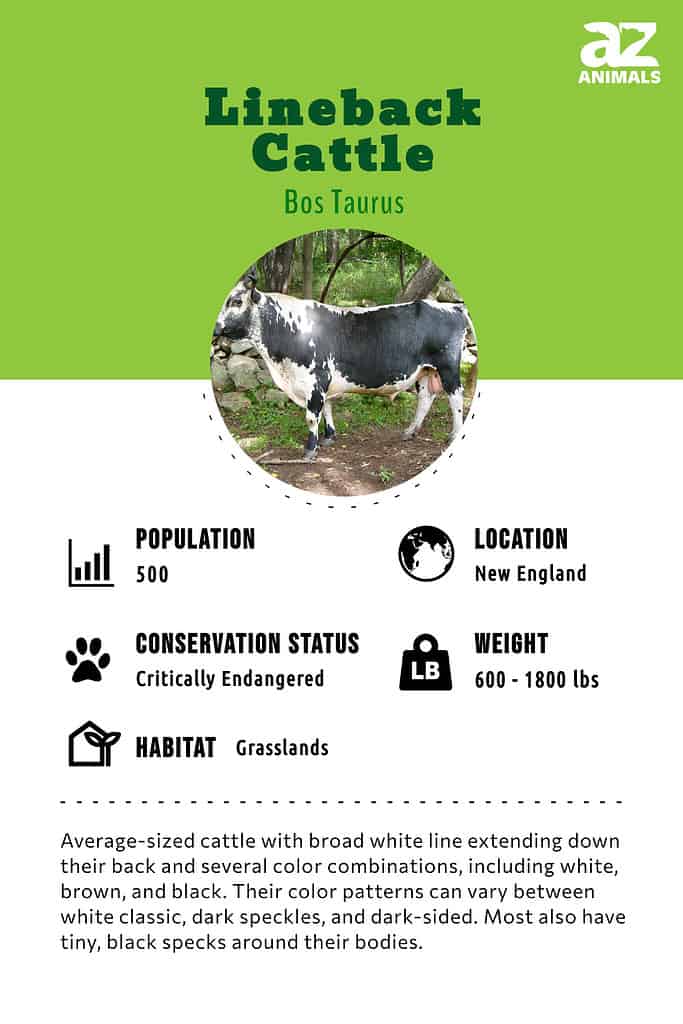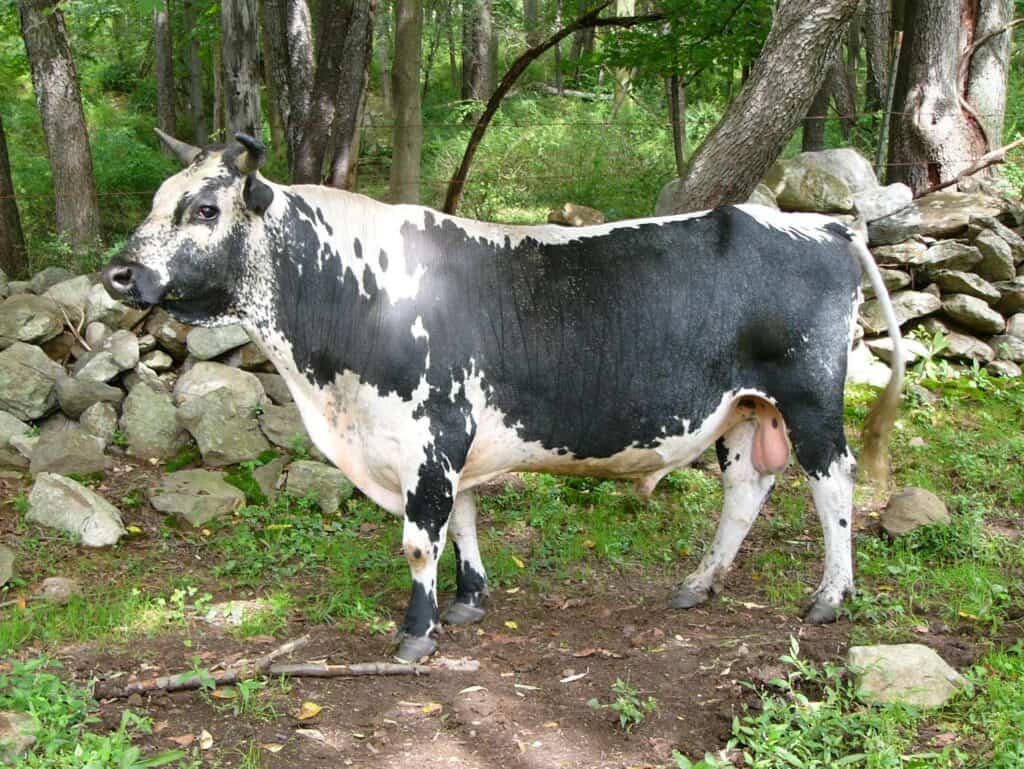Lineback Cattle
Bos Taurus
The lineback cattle has been an integral part of rural New England society for more than 200 years!
Advertisement
Lineback Cattle Scientific Classification
- Kingdom
- Animalia
- Phylum
- Chordata
- Class
- Mammalia
- Order
- Artiodactyla
- Family
- Bovidae
- Genus
- Bos
- Scientific Name
- Bos Taurus
Read our Complete Guide to Classification of Animals.
Lineback Cattle Conservation Status
Lineback Cattle Facts
- Name Of Young
- Calf
- Group Behavior
- Herd
- Fun Fact
- The lineback cattle has been an integral part of rural New England society for more than 200 years!
- Estimated Population Size
- 500
- Biggest Threat
- Cross-breeding
- Most Distinctive Feature
- Thick white line on its back
- Gestation Period
- 8-9 months
- Age Of Independence
- 2 years
- Litter Size
- 1
- Habitat
- grass land
- Predators
- Coyotes, wolves, bears
- Diet
- Herbivore
- Lifestyle
- Herd
- Favorite Food
- Grass
- Common Name
- Randall Lineback
- Origin
- New England
- Location
- New England
- Group
- Herd
View all of the Lineback Cattle images!
“In 2015, the Livestock Conservancy estimated that there are only around 500 lineback cattle left in the world.“
Summary
Named after the line that goes down the middle of their back, the lineback cattle or Randall lineback cattle is a critically endangered rare breed of cattle that is currently being conserved in the United States to prevent extinction. Like most other cattle breeds, they are used for dairy and beef and are generally low maintenance. It is easy to spot lineback cattle due to the thick white line going down their back.

4 Incredible Lineback Cattle Facts
- The population is not even half as much as it was a century ago. The breed was crossbred with Holstein cattle, which led to most of the lineback cattle population disappearing.
- They’re a combination of Dutch, English, and French cattle.
- They are considered a heritage breed and have been integral to rural New England life since the mid-1700s!
- Their name comes from their appearance; they have a thick white line that goes down their back.
Scientific Name, History, and Evolution
The lineback cattle’s scientific name is Bos taurus. Although their exact origin is unknown, they likely first originated in the United States around the time of American Independence. Nowadays, it is a rare breed, but it was much more widely distributed in the 18th and 19th centuries and could have been intermixed with some other breeds that came from Europe during this time.
Like most other cattle, this animal is used for its meat and milk, but over time it has been more favored by the dairy industry. They originated through crossbreeding of the Witrich, Welsh, and Gloucester breeds.
Appearance
Lineback cattle are a distinct breed with a broad white line extending down their back. They usually have several color combinations, including white, brown, and black. Their color patterns can vary between white classic, dark speckles, and dark-sided. Most also have tiny, black specks around their bodies.
The females usually weigh between 600 to 1100 pounds, and the bulls can weigh as much as 1800 pounds (about as much as ten adult male humans)! They are usually between 4-5 feet tall at the shoulder and 7-8 feet long, not including the tail. They are average-sized cattle, and their overall build makes them good draught animals.

Lineback cattle feature broad dark patches on their sides, with a long white line extending down their back.
©CTPhil/CCBY1.0 – License
Behavior
Like most cattle breeds, they live in groups called “herds.” The group often has a male bull as the head, followed by several cows.
They are a very docile breed, but don’t be mistaken. These animals can be extremely stubborn. While they’re easy to control, if threatened or angered, they may panic and react aggressively. Nevertheless, the stubbornness of each cow varies.
Bulls are especially unpredictable. Young uncastrated males are known to fight each other, which can occasionally end in severe injury or death of one of the bulls. Because of this, it is safest to keep bulls in separate areas.
Habitat
These are hardy animals that can live in most climates. This cattle breed is primarily found in New England, so it can withstand cold, harsh winters and warm, humid summers. Some lineback cattle have even been bred in southern states such as Tennessee and Alabama, so they can also survive in hot climates. Since they’re suited for small-scale farming, they are currently being bred in US states where agriculture thrives. They spend their time in grassy areas, grazing and roaming the pastureland.
Diet
The lineback cattle are herbivores that feed on grass, bushes, twigs, weeds, tree leaves, vegetable leftovers, and grains. In the wild, lineback cattle fall prey to predators such as wolves and coyotes.
What Eats Them?
Their main predator is humans. However, while this cattle breed was historically bred for meat consumption, they are not slaughtered as often anymore due to their critically low population.
In the wild, lineback cattle are hunted by animals such as wolves, grizzly bears, black bears, cougars, and coyotes. In addition, scavenger birds such as vultures also feed on dead lineback cattle.
What Do They Eat?
Lineback cattle primarily eat grass. They spend between 6-11 hours per day grazing in large grasslands. They also will eat twigs, leaves or vegetables, fruits, and grains. Many farmers incorporate nutritious grains into their diets.
Predators and Threats
As mentioned, predators mostly include mammals such as wolves, bears, cougars, and coyotes. Therefore, farmers must ensure they have a well-protected pasture or that the cattle are in a safe area at night.
Currently endangered, this cattle breed’s main threat is cross-breeding. Lineback cattle almost went extinct due to cross-breeding, and their numbers have yet to recover. Nonetheless, efforts are being made by the Livestock Conservancy to improve their numbers.
Reproduction
Lineback Cattle have an overall gestation period of nine to 10 months, almost the same as humans. They usually give birth to one calf at a time. In fact, it is incredibly rare for a heifer to give birth to more than one calf. Usually, female cows go into heat every 21 days and moo louder as a mating call.
Directly after birth, the calf should be fed its mother’s colostrum since it is born without an immune system. The colostrum provides the calf with the antibodies it needs to fight infection. The mother feeds the calf for up to six weeks after birth. It is usually ideal for a cow to give birth every two years at most. If the period between pregnancies is less than six months, it becomes risky for the mother.
Babies
The baby of a lineback is known as a calf. Males are called bulls, while females are called heifers. Calves are generally born one at a time and depend heavily on their mothers for the first two months. They usually feed on their mother’s milk for anywhere between three to six weeks. Once weaned, they begin to feed on grass, grains, and hay.
Calves are born without an immune system, so they must drink antibodies through their mother’s milk for the first few weeks of life. A lineback’s calf reaches full adulthood at two years of age.
Lifespan
The average lifespan of a lineback is 10-20 years. Bulls of this rare breed often outlive the heifers. Even though they are critically endangered, they are surprisingly hardy regarding health problems. Other than mites, parasites, and ticks, there are no significant health threats. They have good hooves, sturdy legs, and solid mammary systems. However, one of the underlying issues that have led to their endangerment is fertility issues, which makes them difficult to breed.
Population
Lineback cattle are currently critically endangered. The current population estimate for this breed is only around 500. Efforts are in place to breed them and save this heritage breed, but their fertility issues are making it difficult to improve their numbers.
Zoos
Lineback cattle are commonly found in zoos and farms around the United States. You can go visit them in the following zoos:
Related Animals
View all 98 animals that start with LLineback Cattle FAQs (Frequently Asked Questions)
Are lineback cattle carnivores, herbivores, or omnivores?
Lineback cattle are herbivores; their diet consists of plants, weeds, and grass.
What are lineback cattle used for?
As a dairy cow, lineback cattle can yield up to an average of two gallons of milk per day. They were originally bred as work animals due to their large size and strength.
Are lineback cattle good for small-scale farming?
Lineback cattle adapt well to free-stall housing and grazing, making them good for small-scale farming. But, as they are stubborn creatures, they can sometimes be difficult to manage.
When did the lineback cattle breed originate?
Lineback cattle is a rare American breed that originated between the 18th and 19th centuries.
Thank you for reading! Have some feedback for us? Contact the AZ Animals editorial team.
Sources
- Pet Keen, Available here: https://petkeen.com/lineback-cattle/
- The Cattle Site, Available here: https://www.thecattlesite.com/breeds/dairy/105/lineback
- Dairy Cattle Registry, Available here: http://dairycattleregistry.com/lineback/
- (1970)
- (1970)

















